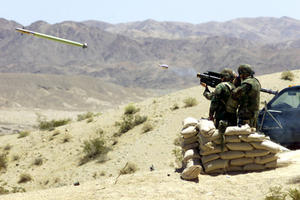Aviation securityDefending U.S. civilian aircraft against shoulder-fired missile may cost $43 billion
Equipping U.S. passenger aircraft with defenses against shoulder-fired missiles may cost $43.3 billion over twenty years, DHS says in an unpublished report; airlines say the expense exceeds the risk, and oppose installing the systems — or, if such installation is made mandatory, than the government should pay for it

Marines firing a Stinger anti-aircraft missile // Source: defense.gov
Equipping U.S. passenger aircraft with defenses against shoulder-fired missiles may cost $43.3 billion over twenty years, DHS says in an unpublished report that may reignite debate about the vulnerability of planes to terrorists.
Airlines say the expense exceeds the risk, and oppose installing the systems, made by BAE Systems Plc and Northrop Grumman Corp.
The missiles “could easily be smuggled into an airport in a Western country,” said Matt Schroeder, manager of the arms- sales project of the Federation of American Scientists, which calls the portable weapons “an imminent and acute threat” to airliners. The Washington, D.C.-based group disclosed the report after obtaining it through a Freedom of Information Act request.
Bollmberg Businessweek’s Angela Greiling Keane writes that the analysis was requested by Congress following the introduction of legislation in 2003 by Democratic Senators Charles Schumer of New York and Barbara Boxer of California that would have required defense systems on U.S. passenger planes. The lawmakers acted a few months after missiles were fired at an Israeli passenger plane in Kenya.
The proposed legislation stalled in disputes over the cost and reliability of the defense equipment. Since then, the BAE and Northrop systems have been tested for live fire and multiple missile attacks during more than 16,000 flight hours on AMR Corp.’s American Airlines’ planes and FedEx Corp.’s cargo jets by DHS officials, who declare the technology effective in the report (“BAE tests counter-missile system on American Airlines aircraft,” 14 December 2007 HSNW). The systems foil attacks by using lasers to deflect heat- seeking missiles.
Keane notes that the $43.3 billion estimate is based on installing, operating and maintaining the defense systems on all large passenger planes, which the report defines as wide-body aircraft and narrow-body planes the size of the Boeing 737 and Airbus A318 and larger. The cost equals almost $12 million over 20 years for each plane, based on 3,636 aircraft as of 2008.
John Verrico, a spokesman for DHS’s Science and Technology Directorate (S&T), confirmed the report’s authenticity in a phone call with Keane.
An attack on a U.S. passenger plane by a shoulder-fired missile would have an economic cost of more than $15 billion, assuming it led to a week-long shutdown of airspace, according to a 2005 report by the Rand Corp., a policy research group based in Santa Monica, California.
The risk of an attack outside a combat zone may be too small to justify the cost of the
